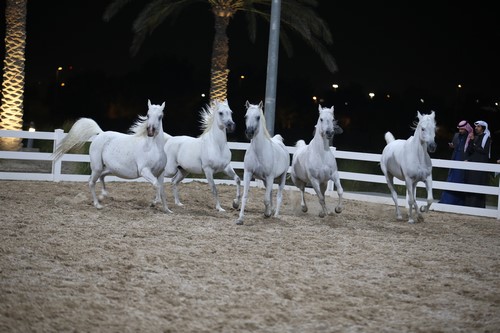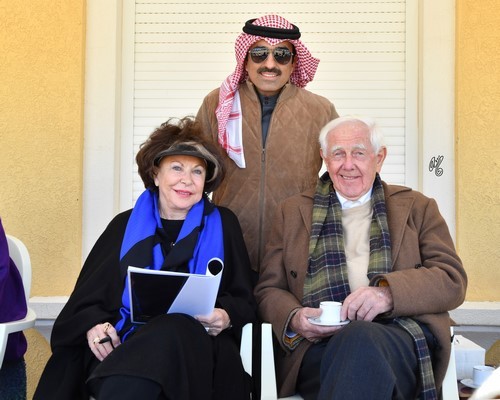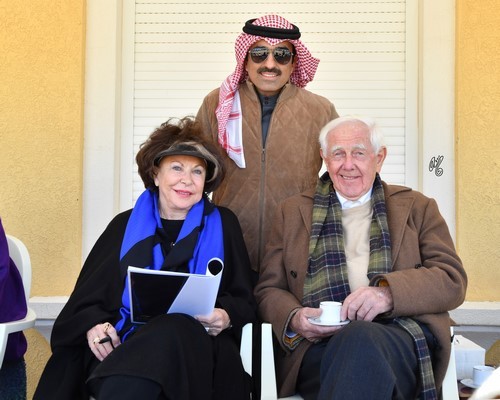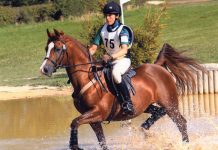The 2017 Kuwait International Arabian Horse Festival, in its entirety, lasted from February 3-21. It began on February 3-4 with the 6th International Championship, followed by two days of Open House Stud Visits which included an exhibition of artwork of the famous artist Mr. Ali Al Mimar at Bait Al Arab.
Then on February 17-18, it continued with the All Nations Cup – Straight Egyptians and three more days of Open House Stud Visits with the exhibition and launch of the book Ansata Hejazi – Born to Rule. Both shows were excellently organized by and hosted at The Arabian Horse Center Bait Al Arab, the State Stud of Kuwait.
Since 2010, Kuwait has hosted National, International and Straight Egyptian events and shows with great success. Due to the diligent level of organization, generous hospitality and thoughtful breeding programs which are producing high quality horses, Kuwait’s growing presence as an International destination for Arabian horses has received great support from all over the world. The 2017 Kuwait International Arabian Horse Festival was attended by huge numbers of people who represented every major continent with involvement in Arabian horses.
 |
| 5 Daughters of Ansata Hejazi at Bait Al Arab – Lulua Elkuwait, Mayyasah Elkuwait, Mesk Elkuwait, Maha Elkuwait, Layali Elkuwait. |
The Launch of the new book Ansata Hejazi – Born to Rule
The Bait Al Arab visit, which took place on the night of February 20th, combined its presentation of horses with the launching of the book, Ansata Hejazi – Born to Rule, by Judith Forbis. The evening was both magical and unforgettable. The festivities began with a very special presentation celebrating the life of Ansata Hejazi through his contribution to the Arabian Horse Center. It is worth recognizing that the arena used for this presentation, like everything else associated with Bait Al Arab, was well designed from the perspectives of function, comfort and beauty – all three were accomplished and nothing was compromised. There were also subtle details to the lighting which added even more warmth and elegance to the occasion.
The presentation opened with a stallion the Arabian Horse Center acquired in 2014, the Ansata Hejazi son, Ansata Sheikh Halim (x Ansata Samiha), bred by Chase Arabians LLC and Ansata Arabian Stud. Then both in groups and one-by-one, pearls of the program were presented until the breath-taking finale, one that everyone who was fortunate enough to attend, will never forget: five beautiful Ansata Hejazi daughters were presented together at liberty…I do not exaggerate when I write, for that moment in time, it felt as if the entire world stopped turning to honor the heritage of these mares and the depth of their value to the county of Kuwait.
On May 8, 1992 Ansata Hejazi was born at Ansata Arabian Stud, owned by Donald and Judith Forbis, in Mena, Arkansas (USA). He was by their chief sire, Ansata Halim Shah and out of Ansata Sudarra, who traced back to Ansata Bint Bukra, one of the Ansata Foundation horses. In 1999, even though he was not for sale, Mr. Mohammed J. Al Marzouq of Kuwait, purchased Ansata Hejazi, along with the mares: Ansata Nefertiti (a full sister to Ansata Hejazi), Ansata Samari (Ansata Hejazi x Ansata Samari) and Ansata Shalimar (Prince Fa Moniet x Ansata Samantha). Although Ansata Hejazi’s career as an important sire began in the United States, through the intelligence, generosity and foresight – all in equal parts – of Mr. Al Marzouq, not only did his significance come to be appreciated all over the world, but also and more importantly, he influenced a single nation as no other stallion has before, and very possibly, ever will again.
 |
| Lisa Abraham, Abdullah Hatiyah, Joanna Jonientz |
Lisa Abraham: What was your attraction to Ansata Hejazi?
Mr. Al Marzouq: I bought Ansata Hejazi when he was 6 years of age. I was very impressed with his classic type, charisma and conformation and, most importantly, that these traits were just as visible in his foals.
Lisa: His breeder, Judith Forbis, has stated that Ansata Hejazi was “…the right horse, at the right time.” From the perspective of the rebuilding of Kuwait following the Iraqi invasions, can you elaborate on this statement? Please also include the qualities that you felt he possessed as a sire and/or unique circumstances which allowed him such influence.
Mr. Al Marzouq: After the invasion, there were only 26 Arabian registered horses left in Kuwait and there was no real stallion power. Hence, when I was considering Ansata Hejazi I was thinking first of my country’s interest before my own breeding purposes. For that reason, he was open to public use at no charge. Due to his ability to produce both stallions and mares of equal eminence, he provided a strong foundation for Kuwaiti breeders and was indispensable to the establishment of the straight Egyptian program in Kuwait.
Lisa: Ansata Hejazi – Born to Rule is an incredible tribute to a stallion who has known unique notoriety. Can you share some of your own feelings?
Mr. Al Marzouq: For as long as I can remember, it had been my ambition to not only be a proud owner of Arabian horses and to participate in the development and perfection of their breeding, but also to make a contribution to the establishment of their blood lines, in the land of their forefathers. With Ansata Hejazi, my breeding goals have been achieved and, within a very short period, Kuwait has become a leader among the best straight Egyptians breeding programs available.
The idea of this book was initiated by Judith, to whom I gave my full support. For me this book is honors both Ansata Hejazi and his breeders. I was fortunate to get Don and Judith’s support as Ansata Hejazi was a wonderful stallion who was reason for my country’s unique position in the breeding of straight Egyptian horses. On the night of the book release, it was very emotional for me to see how much this stallion was loved by so many people. For me Ansata Hejazi will always be remembered as the stallion who helped me achieve my dreams and brought joy to my life.
After the presentation of the Bait Al Arab horses, all guests adjourned to a gallery thoroughly staged to accommodate the release of this historic manuscript, celebrating the life of Ansata Hejazi and his contribution to Kuwait. Throughout the gallery were beautiful displays and diagrams from the book and gorgeous artistic portrayals of this beloved stallion. The energy of the occasion was amazingly high as the room was packed full of people eager to participate in this special moment–it was easy to observe that history was being made and everyone wanted to celebrate in it. Its author Judith Forbis was present for the occasion and was accompanied by Mr. Marzouq and Sheikh Hamad bin Ali Al Thani, of Al Shaqab Stud (QAT). When all the photos and videos had been taken, interviews done, speeches made, as a group, we walked a path through the cool, clear night air to a series of tents where we shared a traditional meal, accompanied by the music of the region. It was a story book ending to a perfect evening.
Judith Forbis: After more than two years of developing this book in cooperation with managing editor Cynthia Culbertson and other important contributors, it was a supreme pleasure for me to assist in hosting Hejazi’s many international fans who attended the launch of this long-anticipated publication. Although the entire evening was filled with excitement and charged with energy, the ribbon cutting ceremony, prior to entering the exhibition hall, was very emotional for me. I was unaware of that part of the agenda, so it came as a complete surprise. It was an unforgettable opportunity to share that experience with numerous long-time friends and I will always cherish that memory.
I am especially grateful to Bait Al Arab’s team who worked so diligently to provide a perfect presentation of Hejazi-influenced stallions, mares and foals as a tribute to this noble stallion. Turning loose the five Hejazi daughters as an artful and breathtaking conclusion to the State Stud’s presentation deeply touched my heart and brought back memories of Hejazi’s birth. From the time he was born, he appeared to be a very special gift from above. Endowed with a heavenly white star on his forehead and with silver hairs surrounding his inquisitive large eyes, we knew he would one day become white – a color symbolic of victory and success. However, at that time, we could not foresee that he would eventually become ‘a king’ and live up to the Arab saying about the white horse, ‘This is the mount of kings, because it brings good fortune and luck, and with it you are able to obtain what is necessary.’ He was smart, kind and gentle yet aristocratic in demeanor. His classic beauty, overall balance and bold long-reaching trot impressed all who saw him. As he grew into a magnificent and charismatic stallion, winning in the show ring and siring outstanding foals, he indeed proved to be a special gift.
I remember so well the day when Mohammed came to Ansata, in 1999. After seeing Hejazi at the Egyptian Event in Lexington, he was absolutely determined to buy him. Although Don and I were adamant about his importance to our own breeding program, Mohammed convinced us that Hejazi could serve to inspire and elevate the Arabian horse breeding programs in Kuwait after its devastation from the Gulf War. So, after much consideration, we agreed to let Hejazi return to the land of his ancestors. Although we had great confidence in Hejazi’s future as a sire in that country, we could have never guessed the unbelievable impact this stallion would have–and still does have–through succeeding generations carrying his blood. As his breeder, even I am overwhelmed by his accomplishments. To me, he was a real live horse hero–not just a fictional one conceived in an author’s mind.
For more than two decades Ansata bloodlines have been a major influence in Kuwait’s well-planned breeding programs. It has been a life-fulfilling experience for me to have been involved in the dramatic restoration of the country’s Arabian horse heritage. In a very short period of time, Kuwait has firmly established itself as a prime destination in the Arabian horse world. Considering Hejazi’s immeasurable contribution to this nation, it is no wonder its patriotic breeders fondly called him the ‘King of Kuwait’.
We will continue our coverage from Kuwait later this week, with coverage of the All Nations Cup – Straight Egyptians.
Lisa Abraham is an International Journalist and Photographer from the United States. Although she does freelance for various media, her primary dedication is to Arabhorse.com as a Premier Contributor and Representative. She is also a breeder of Straight Egyptian Arabians www.lisaabrahamphotography.com













Perhaps an idea. My age is nearly90 and i have a gold pyramid pin bought from judy Do you know who is interested ?